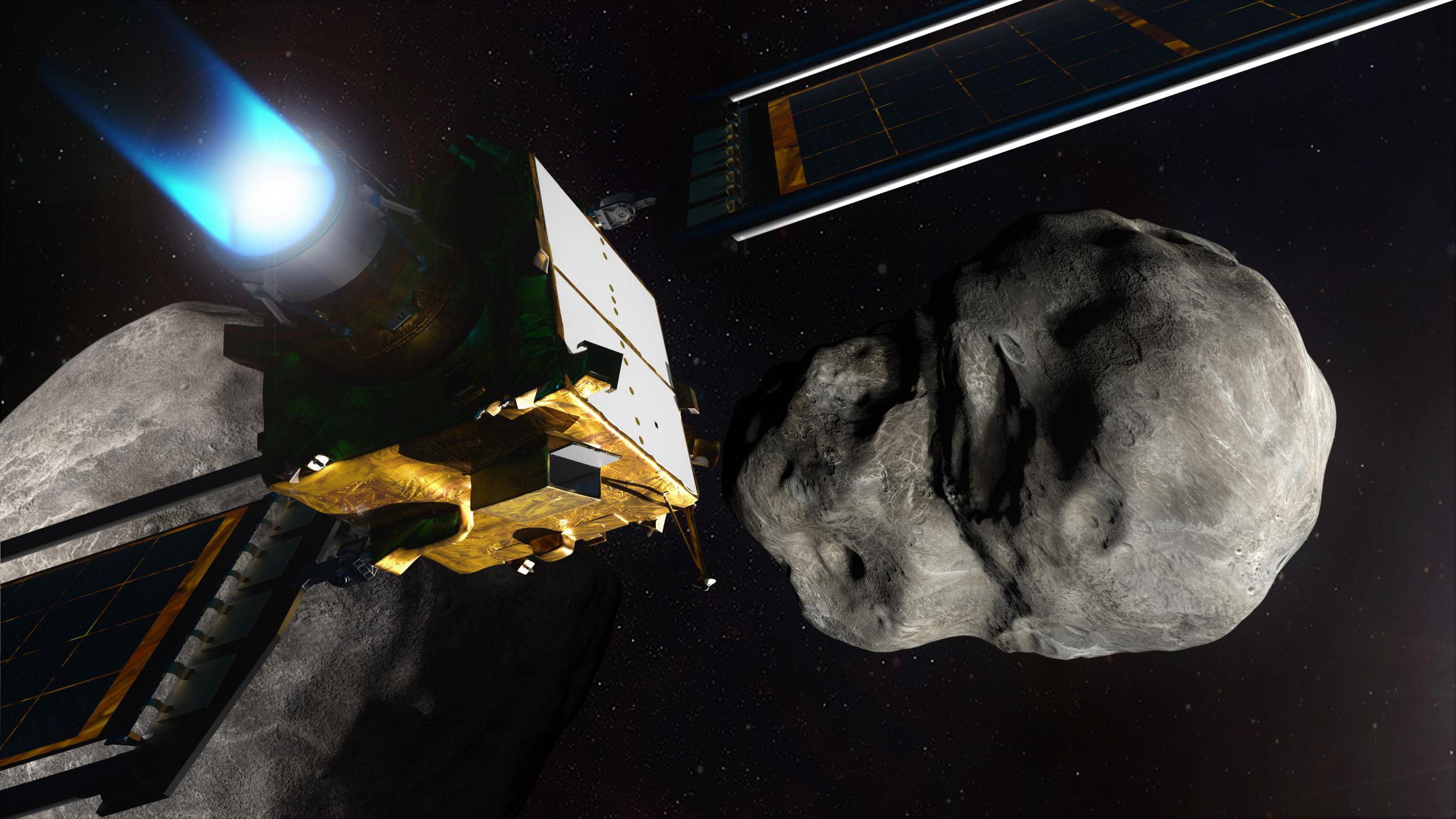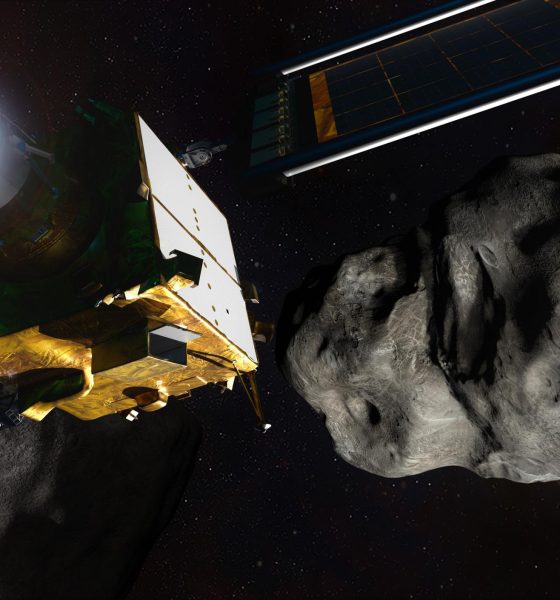

News
SpaceX almost ready to launch NASA asteroid impact spacecraft
Update: The NASA official quoted saying that the DART spacecraft had arrived at Vandenberg on September 27th appears to have been incorrect and may have accidentally confused the arrival of an “advance team” with the arrival of the spacecraft itself.
Science communicator and author David Brown was reportedly on-site on September 29th to watch as the DART spacecraft was carefully packaged for the journey from Maryland’s Johns Hopkins University to its California launch site, obviously making a VSFB arrival two days prior impossible. Nevertheless, now stowed inside an environmentally-controlled shipping container, DART should still arrive at Vandenberg within the next week or two.
Revealed as a side note during live coverage of the space agency’s successful Landsat-9 launch, NASA says that the Double Asteroid Redirect Test (DART) spacecraft has arrived at Vandenberg Space Force Base (VSFB) ahead of a SpaceX Falcon 9 launch less than two months from now.
Weighing around 690 kg (~1500 lb) at liftoff, NASA confirmed that the DART spacecraft and its Italian-built LICIACube smallsat companion are on track to launch out of SpaceX’s VSFB SLC-4E pad on a Falcon 9 rocket no earlier than (NET) November 23rd, 2021. Carrying its small passenger, DART will then make a beeline for binary asteroid pair Didymos and Dimorphos. Respectively measuring around 800 and 170 meters across, DART will ultimately target the smaller of the pair and accelerate to an impact velocity of ~6.6 km/s (4 mi/s or Mach 19).
DART will then rely on a built-in telescope and closed-loop targeting software to home in on and smash into Dimorphos, ultimately using the tiny asteroid system as a sort of sandbox to test theories of asteroid redirection that might one day help humans prevent catastrophic impacts with Earth.
Originally targeted to launch in June 2021 when NASA awarded SpaceX the $69M launch contract (now up to $73M after two small changes) in April 2019, DART has slipped approximately five months in the 2.5 years since when a few minor technical issues arose late in development. Impressively, almost none of those delays appear to have been caused by the COVID-19 pandemic, which cannot be said for a number of other NASA, US military, and commercial satellites and launches.
Set to cost a total of ~$250M including launch services, DART’s main purpose is to determine how exactly an asteroid behaves when impacted by a high-velocity spacecraft. Whereas depictions of asteroid “redirection” in popular science fiction tend to lean towards the “send an arsenal of nuclear bombs” approach, the reality is that bombing most asteroids and comets large enough to threaten the surface of Earth would add uncertainty more than it would mitigate the threat.
Given how little is actually known about the physical characteristics of asteroids, attacking one with a bomb could simply separate a killer asteroid into any number of smaller, still-deadly asteroids – now spread into a shotgun-like pattern of undetectable fragments instead of one large, visible object. Instead, most modern science on the matter now believes that the best route to redirection is a combination of early detection and a (relatively) low-energy impact. A bit like the concept of the butterfly effect, a relatively gentle impact (still akin to 2.5 tons of TNT with DART) years or decades in advance could drastically change the trajectory of the threatening asteroid or comet, causing it to miss Earth. DART won’t directly prevent an asteroid from impacting Earth but hitting the asteroid moon of a larger asteroid should effectively magnify the effect the tiny impact has on its orbital characteristics.
DART will also serve as a technology demonstration, debuting both satellite-class roll-out solar arrays and NASA’s self-developed NEXT-C electric propulsion system. With any luck, it will also help scientifically prove that humans could use a similar approach to save ourselves from a catastrophic space impact event years or decades from now.

News
Tesla FSD fleet is nearing 7 billion total miles, including 2.5 billion city miles
As can be seen on Tesla’s official FSD webpage, vehicles equipped with the system have now navigated over 6.99 billion miles.

Tesla’s Full Self-Driving (Supervised) fleet is closing in on almost 7 billion total miles driven, as per data posted by the company on its official FSD webpage.
These figures hint at the massive scale of data fueling Tesla’s rapid FSD improvements, which have been quite notable as of late.
FSD mileage milestones
As can be seen on Tesla’s official FSD webpage, vehicles equipped with the system have now navigated over 6.99 billion miles. Tesla owner and avid FSD tester Whole Mars Catalog also shared a screenshot indicating that from the nearly 7 billion miles traveled by the FSD fleet, more than 2.5 billion miles were driven inside cities.
City miles are particularly valuable for complex urban scenarios like unprotected turns, pedestrian interactions, and traffic lights. This is also the difference-maker for FSD, as only complex solutions, such as Waymo’s self-driving taxis, operate similarly on inner-city streets. And even then, incidents such as the San Francisco blackouts have proven challenging for sensor-rich vehicles like Waymos.
Tesla’s data edge
Tesla has a number of advantages in the autonomous vehicle sector, one of which is the size of its fleet and the number of vehicles training FSD on real-world roads. Tesla’s nearly 7 billion FSD miles then allow the company to roll out updates that make its vehicles behave like they are being driven by experienced drivers, even if they are operating on their own.
So notable are Tesla’s improvements to FSD that NVIDIA Director of Robotics Jim Fan, after experiencing FSD v14, noted that the system is the first AI that passes what he described as a “Physical Turing Test.”
“Despite knowing exactly how robot learning works, I still find it magical watching the steering wheel turn by itself. First it feels surreal, next it becomes routine. Then, like the smartphone, taking it away actively hurts. This is how humanity gets rewired and glued to god-like technologies,” Fan wrote in a post on X.
News
Tesla starts showing how FSD will change lives in Europe
Local officials tested the system on narrow country roads and were impressed by FSD’s smooth, human-like driving, with some calling the service a game-changer for everyday life in areas that are far from urban centers.

Tesla has launched Europe’s first public shuttle service using Full Self-Driving (Supervised) in the rural Eifelkreis Bitburg-Prüm region of Germany, demonstrating how the technology can restore independence and mobility for people who struggle with limited transport options.
Local officials tested the system on narrow country roads and were impressed by FSD’s smooth, human-like driving, with some calling the service a game-changer for everyday life in areas that are far from urban centers.
Officials see real impact on rural residents
Arzfeld Mayor Johannes Kuhl and District Administrator Andreas Kruppert personally tested the Tesla shuttle service. This allowed them to see just how well FSD navigated winding lanes and rural roads confidently. Kruppert said, “Autonomous driving sounds like science fiction to many, but we simply see here that it works totally well in rural regions too.” Kuhl, for his part, also noted that FSD “feels like a very experienced driver.”
The pilot complements the area’s “Citizen Bus” program, which provides on-demand rides for elderly residents who can no longer drive themselves. Tesla Europe shared a video of a demonstration of the service, highlighting how FSD gives people their freedom back, even in places where public transport is not as prevalent.
What the Ministry for Economic Affairs and Transport says
Rhineland-Palatinate’s Minister Daniela Schmitt supported the project, praising the collaboration that made this “first of its kind in Europe” possible. As per the ministry, the rural rollout for the service shows FSD’s potential beyond major cities, and it delivers tangible benefits like grocery runs, doctor visits, and social connections for isolated residents.
“Reliable and flexible mobility is especially vital in rural areas. With the launch of a shuttle service using self-driving vehicles (FSD supervised) by Tesla in the Eifelkreis Bitburg-Prüm, an innovative pilot project is now getting underway that complements local community bus services. It is the first project of its kind in Europe.
“The result is a real gain for rural mobility: greater accessibility, more flexibility and tangible benefits for everyday life. A strong signal for innovation, cooperation and future-oriented mobility beyond urban centers,” the ministry wrote in a LinkedIn post.
News
Tesla China quietly posts Robotaxi-related job listing
Tesla China is currently seeking a Low Voltage Electrical Engineer to work on circuit board design for the company’s autonomous vehicles.

Tesla has posted a new job listing in Shanghai explicitly tied to its Robotaxi program, fueling speculation that the company is preparing to launch its dedicated autonomous ride-hailing service in China.
As noted in the listing, Tesla China is currently seeking a Low Voltage Electrical Engineer to work on circuit board design for the company’s autonomous vehicles.
Robotaxi-specific role
The listing, which was shared on social media platform X by industry watcher @tslaming, suggested that Tesla China is looking to fill the role urgently. The job listing itself specifically mentions that the person hired for the role will be working on the Low Voltage Hardware team, which would design the circuit boards that would serve as the nervous system of the Robotaxi.
Key tasks for the role, as indicated in the job listing, include collaboration with PCB layout, firmware, mechanical, program management, and validation teams, among other responsibilities. The role is based in Shanghai.
China Robotaxi launch
China represents a massive potential market for robotaxis, with its dense urban centers and supportive policies in select cities. Tesla has limited permission to roll out FSD in the country, though despite this, its vehicles have been hailed as among the best in the market when it comes to autonomous features. So far, at least, it appears that China supports Tesla’s FSD and Robotaxi rollout.
This was hinted at in November, when Tesla brought the Cybercab to the 8th China International Import Expo (CIIE) in Shanghai, marking the first time that the autonomous two-seater was brought to the Asia-Pacific region. The vehicle, despite not having a release date in China, received a significant amount of interest among the event’s attendees.








